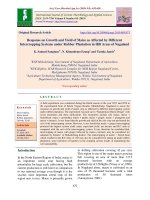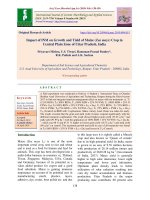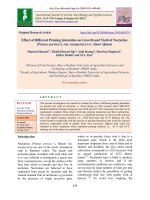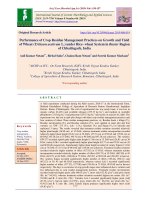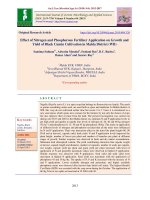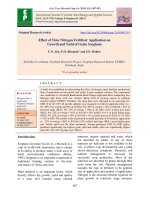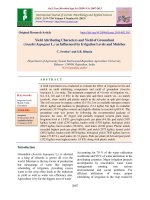Weed pressure on growth and yield of groundnut (Arachis hypogaea L.) in Meghalaya, India
Bạn đang xem bản rút gọn của tài liệu. Xem và tải ngay bản đầy đủ của tài liệu tại đây (258.12 KB, 7 trang )
Int.J.Curr.Microbiol.App.Sci (2018) 7(3): 2852-2858
International Journal of Current Microbiology and Applied Sciences
ISSN: 2319-7706 Volume 7 Number 03 (2018)
Journal homepage:
Original Research Article
/>
Weed Pressure on Growth and Yield of
Groundnut (Arachis hypogaea L.) in Meghalaya, India
Santosh Korav1*, Vishram Ram1, Lala I.P. Ray1, R. Krishnappa2,
N.J. Singh1 and N. Premaradhya1
1
School of Natural Resource Management, College of PG-Studies, Umiam-793103,
Meghalaya, India
2
ICAR RC for NEH Region, Umiam, Meghalaya, India
*Corresponding author
ABSTRACT
Keywords
Season, Weeds,
Growth, Days after
emergence, Yield
Article Info
Accepted:
24 February 2018
Available Online:
10 March 2018
In two consecutive seasons a field experiment was conducted in randomised block design
replicated thrice with twelve treatments including two sets of treatments, viz. initial weedy
and initial weed free treatment with 15 days interval up to harvesting. They are weeds up
to 15, 30, 45, 60, 75 days after emergence (DAE), weedy treatment and weed free up to 15,
30, 45, 60, 75, weed free treatment to assess the effect of weed flora on growth and yield
of groundnut. The results show that the growth parameters like Plant height (59.80, 50.56
and 55.18 cm), Dry matter (28.12, 24.49 and 26.3 g/plant), LAI (2.56, 2.47, 2.51) and yield
attributes of groundnut were significantly with increasing of initial weed free treatments
and highest number of pods per plant (22.20, 16.52 and 18.80), number of seeds per pod
(1.90, 1.80 and 1.85), seed index (24.01, 23.52 and 23.59), seed yield (1.35, 0.94 and 1.15
t/ha) and STOVER yield (3.87, 3.37 and 3.62 t/ha) and Harvest index (50.24, 21.84 and
23.86%) were found in weed free check. Similarly, lowest was found in weedy check in
both season.
Introduction
Groundnut, known as king of oilseeds grown
in India and is one of the most important food
as well as cash crop of our country. It is
gaining importance due to its contents namely,
48-50% of oil and 26-28% of protein. It’s
photo insensitive, mid-season drought tolerant
and has wide range of adaptability to various
agro-climatic situations. Globally, Groundnut
is grown on an area of 24.38 million ha, 40.78
million metric tons of production with 1.67
metric tons productivity during 2016
(FAS/USDA, 2016). In India, it is cultivated
over an area of 4.50 million hectares, with a
production of 4.70 million metric tons.
However, its productivity is low (1.04 metric
tons per hectares) when compared to worlds’
average productivity (FAS/USDA, 2016).
During crop growth, many weeds cause losses
in groundnut yield by competing for water,
space, light and nutrients with crop. It is
necessary to maintain the crops in a weed-free
condition during the critical period for cropweed competition to maintain high yields
2852
Int.J.Curr.Microbiol.App.Sci (2018) 7(3): 2852-2858
(Islam et al., 2016). So if it is weed-free at
initial stage of crop growth, then the weeds
that come up later are also suppressed,
resulting in lower weed density leading to
vigorous growth of the crop. In rice field,
weeds especially barnyard grass at later stage
competes for light and getting higher light use
efficiency as well as shades the crop and
reduces the quality and quantity of light
received by rice plant as compare to initial
stage of crop growth (Concenco et al., 2009).
Under consideration of these things, going to
evaluate what are the effects of weeds and
there density on growth and yield of
groundnut in Meghalaya.
Materials and Methods
The
experiment
was
conducted
at
experimental farm of the College of
Postgraduate Studies (CAU), Umiam,
Meghalaya, India in both Kharif and Rabi
seasons of the year 2016-17. The experimental
site was located at 091°54.72’ E longitude and
25°40.886’ N latitude and at an altitude of 950
m above the mean sea level (MSL). The soil
of the experimental site is sandy clay loam in
texture. pH (4.9), Organic carbon (0.77%),
NPKS (282.24, 13.04, 241.98, 1.6 kg/ha). The
experiment was conducted in a randomized
block design, replicated thrice with twelve
treatments, viz. weeds until 15 DAE, weeds
until 30 DAE, weeds until 45 DAE, weeds
until 60 DAE, weeds until 75 DAE, weedy
treatment and weed free until 15 DAE, weed
free until 30 DAE, weed free until 45 DAE,
weed free until 60 DAE, weed free until 75
DAE, weed free treatment. ‘ICGS-76’ is the
variety of Groundnut was sown in June 23
(Kharif), and November 22 (Rabi) during both
the experimental seasons with plant spacing of
40 x 10 cm2 on flat beds. Recommended doses
of N, P and K = 25:60:60 NPK kg/ha (Full
doses N, P and K were applied at the time of
sowing) Standard agronomic practices were
followed during crop growth period and crop
was harvested after physiological maturity.
Randomly, ten plants were selected from each
plot and regular biometric observations were
taken for growth and yield of crop at DAE to
harvest with an interval of 15 days.
The analysis of data was done using the
Fisher’s method of analysis of variance
technique as described by Gomez and Gomez
(1984). The differences of means were
identified by Duncan’s univariate test at P ≥
0.05.
Results and Discussion
The most dominated weed floras in both
experimental seasons was listed in Table 1.
Grassy weeds are most dominated weed spices
in both seasons of groundnut.
Plant height
The results of plant height data was shown in
Table 2. Different weedy and weed free
treatment was significantly affected on plant
height. The highest plant height was found in
season long weed free treatment with 68.15,
57.76 and 62.95 in Kharif, Rabi and Pooled,
respectively. The competitive ability of the
groundnut increased with the increasing space
occupied by the plants as well as weeds.
Weeds grow faster than groundnut at initial
stage and cover the plant canopy and the lower
space reduces the resource availability by the
individual plant, this might be reducing the
height of groundnut plant. However, the
height of weeds increased with respect to its
dominance over the crop. Thus, cumulative
effect decreased the height of the groundnut
plant. Hakim et al., (2013) observed that the
plant height of rice was significantly
influenced by weed competition period,
increased the length of weed interference and
caused shortest plant. The taller plants were
found in weed free check while the weedy
check treatment resulted in shorter plants.
2853
Int.J.Curr.Microbiol.App.Sci (2018) 7(3): 2852-2858
Dry matter accumulation (g/plant)
The dry matter accumulation in the plant
increased with progression of growth period of
the groundnut during both seasons of the
experimentation. Further, the dry matter
accumulation of Kharif season was higher
than the Rabi irrespective of its growth stages.
Weed free check treatment accumulated
higher dry matter with 28.12, 24.49 and 26.3
g/plant at harvest in Kharif, Rabi and Pooled,
respectively than the other periods of weed
free and weedy plots. However, the lowest
production was associated with the weedy
plots. Due to accumulation of large quantity of
dry matter by plants with better leaf canopy
development, which made the plants to utilize
the available resources more efficiently for
photosynthesis and translocation to different
parts, which intern resulted in higher dry
matter production. Karkanis et al., (2012)
reported that the dry weight of parsley reduced
with increasing duration of weed pressure,
confirming the high sensitivity of the parsley
crop to weed interference.
Leaf area index
The leaf area index of groundnut was
significantly affected by increasing the length
of weed interference period and, conversely
favourably influenced by the increasing span
of weed free period, up to 75 DAE during both
Kharif and Rabi season. Further, at 75 DAE
the greater leaf area index was observed in
season long weed free treatment with 2.56,
2.47, 2.51 in Kharif, Rabi and Pooled,
respectively. However, the lowest leaf area
index was observed in weedy treatment.
Table.1 Weed composition of Groundnut in two season of the experiment
Sl. No
Scientific name
Ageratum conyzoides
1
Ageratum houstonianum
2
Amaranthus spp.
3
Ambrosia artemisiifolia
4
Bidens
pilosa
5
Borreria hispida
6
Borreria latifolia
7
Celosia argentina
8
Commelina bengalensis
9
Cynodon dactylon
10
Cyperus iria
11
Cyperus rotundus
12
Dactyloctenium
aegyptium
13
Digitaria cillaris
14
Digitaria marginata
15
Digitaria sangvinalis
16
Echinochloa colonum
17
Echinochloa crusgalli
18
Eleusine indica
19
Galinsoga parviflora
20
Mimosa
pudica
21
Panicum psilopodium
22
Panicum trypheron
23
Spermotica latifolia
24
+
weed present and - weed missing
Common name
Nilam (Goat weed)
Goat weed
Pigweed
Stick weed
Spanish needle
Thaarthaval
Broadleaf button weed
White cock's comb
Benghal dayflower
Bermuda grass
Yellow nut sedge
Purple nut sedge
Crow foot grass
Southern crabgrass
Finger grass
Crabgrass
Swanki
Barnyard grass
Goose grass
Potato weed
touch me not
Barefoot panicgrass
Panic grass
False button weed
2854
Kharif
+
+
+
+
+
+
+
+
+
+
+
+
+
+
+
+
+
+
+
+
+
Rabi
+
+
+
+
+
+
+
+
+
+
+
+
+
+
+
+
+
+
+
Int.J.Curr.Microbiol.App.Sci (2018) 7(3): 2852-2858
Table.2 Effect of different weedy and weed free periods on groundnut Plant height, Dry matter content (at harvest) and
Leaf area index (at 75 DAE)
Treatments
Weeds until 15 days
Weeds until 30 days
Weeds until 45 days
Weeds until 60 days
Weeds until 75 days
Weedy plot
Weed free until 15 days
Weed free until 30 days
Weed free until 45 days
Weed free until 60 days
Weed free until 75 days
Weed Free plot
LSD (p=0.05)
Kharif
60.08abc
58.98abc
57.05abc
56.21abc
54.90bc
49.68c
57.16abc
58.42abc
59.58abc
59.80abc
62.08ab
68.15a
10.59
Plant height (cm)
Rabi
Pooled
50.81ab
55.44b
50.07ab
54.53b
48.36ab
52.71b
47.56ab
51.89bc
46.04ab
50.47bc
41.57b
45.63c
48.24ab
52.70b
49.58ab
54.00b
50.32ab
54.95b
50.56ab
55.18b
52.95ab
57.51ab
57.76a
62.95a
10.08
5.19
Kharif
20.83b
17.78bc
16.56cd
15.53cd
13.77de
11.02e
25.10a
25.53a
26.25a
26.52a
26.77a
28.12a
3.41
Plant dry matter (g)
Rabi
Pooled
19.11c
19.97de
18.20cd
17.99e
13.06f
14.81f
11.29f
13.41fg
12.18f
12.98fg
11.63f
11.32g
15.64e
20.37de
18.59cd
22.06bcd
16.70de
21.48cd
21.14b
23.83abc
22.81ab
24.79ab
24.49a
26.30a
1.96
1.40
Kharif
2.42bc
2.35c
2.35c
2.18d
2.17d
2.12d
2.48ab
2.48ab
2.49ab
2.52ab
2.53a
2.56a
0.09
LAI
Rabi
1.58de
1.56de
1.44e
1.44e
1.43e
1.38e
1.75cd
1.91bc
2.05b
2.51a
2.44a
2.47a
0.26
Pooled
2.00cde
1.96cde
1.89de
1.81e
1.80e
1.75e
2.11bcd
2.20bc
2.27ab
2.51a
2.48a
2.51a
0.10
*Figures not sharing the same letters in the same column differs significantly at p<0.05
Table.3 Effect of different weedy and weed free periods on groundnut yield components
Treatments
Weeds until 15 days
Weeds until 30 days
Weeds until 45 days
Weeds until 60 days
Weeds until 75 days
Weedy plot
Weed free until 15 days
Weed free until 30 days
Weed free until 45 days
Weed free until 60 days
Weed free until 75 days
Weed Free plot
LSD (p=0.05)
Number of pods per plant
Kharif
6.20f
14.63b
13.07c
11.77d
9.47e
8.50e
8.40e
10.87d
12.97c
14.27b
15.10b
22.20a
1.18
Rabi
12.65c
11.23d
10.49e
8.46g
7.94g
6.99h
7.34h
9.19f
11.36d
12.78c
13.52b
16.52a
0.59
Pooled
14.37bc
12.80d
11.72e
9.99f
9.18g
8.17h
8.29h
10.57f
12.81d
14.24c
15.06b
18.80a
0.54
Number of seeds per pod
Kharif
1.87a
1.73ab
1.37bcd
1.43bcd
1.23cd
1.03d
1.20cd
1.40bcd
1.50abc
1.57abc
1.73ab
1.90a
0.38
*Figures not sharing the same letters in the same column differs significantly at p<0.05
2855
Rabi
1.80a
1.78ab
1.57ef
1.68bcde
1.61def
1.46g
1.54fg
1.59def
1.64cdef
1.69bcd
1.73abc
1.78ab
0.1
Pooled
1.85a
1.82ab
1.64ef
1.73cd
1.65ef
1.50g
1.58f
1.63ef
1.69de
1.74cd
1.77bc
1.82ab
0.05
Seed index (g)
Kharif
23.67a
21.80abc
20.83bcd
20.17cde
19.52de
19.03e
18.20e
20.00cde
20.87bcd
23.13ab
23.87a
24.01a
2.2
Rabi
23.52a
21.79abc
20.64bcd
20.02cd
18.84de
18.77de
17.04e
19.20d
19.97cd
22.18ab
23.09a
23.28a
1.76
Pooled
23.59a
21.80bc
20.74cd
20.09def
19.18ef
18.90f
17.62g
19.60def
20.42de
22.65ab
23.48a
23.64a
1.00
Int.J.Curr.Microbiol.App.Sci (2018) 7(3): 2852-2858
Table.4 Effect of weeds on seed and stover yield and harvest index
Treatments
Seed yield (t/ha)
Kharif Rabi
Pooled
Stover yield (t/ha)
Kharif Rabi
Pooled
HI (%)
Kharif
Rabi
Pooled
Weeds until 15 days
1.30b
0.88b
1.09b
3.62a
3.15c
3.39a
48.11d
21.84cd 24.11bc
Weeds until 30 days
1.12d
0.78d
0.95d
3.05a
2.65f
2.85a
46.83e
22.72a
24.81a
Weeds until 45 days
0.98e
0.68e
0.83e
2.98a
2.60g
2.79a
43.84g
20.76e
22.73e
Weeds until 60 days
0.86fg 0.60fg
0.73fg
2.64a
2.30i
2.47a
44.91fg
20.69e
22.63e
Weeds until 75 days
0.85g
0.59g
0.72fg
2.64a
2.29i
2.46a
41.93h
20.60e
22.53e
Weedy plot
0.82h
0.52i
0.67h
2.54a
2.21j
2.38a
51.34a
18.94g
21.63f
Weed free until 15 days
0.83h
0.56h
0.70gh
2.56a
2.23j
2.39a
45.52ef
20.22e
22.30e
Weed free until 30 days
0.88f
0.62f
0.75f
2.90a
2.52h
2.71a
46.48e
19.64f
21.52f
Weed free until 45 days
1.13d
0.77d
0.95d
3.25a
2.83e
3.04a
48.66cd
21.40d
23.55d
Weed free until 60 days
1.19c
0.83c
1.01c
3.35a
2.92d
3.13a
49.50bc 22.15bc 24.20bc
Weed free until 75 days
1.35a
0.94a
1.14a
3.73a
3.25b
3.49a
49.71bc 22.40ab 24.48ab
Weed Free plot
1.35a
0.94a
1.15a
3.87a
3.37a
3.62a
50.24ab 21.84cd 23.86cd
LSD (p=0.05)
0.03
0.02
0.01
NS
0.04
NS
*Figures not sharing the same letters in the same column differs significantly at p<0.05
2856
1.27
0.51
0.28
Int.J.Curr.Microbiol.App.Sci (2018) 7(3): 2852-2858
Weed floras in Kharif and Rabi season
The natural weed community was composed of
23 and 19 different species during 2016-17 in
Kharif and Rabi, respectively. However, during
both seasons, dominant weed species were very
similar (Table 1).
Yield component and yields of groundnut
Results of number of pods per plant, number of
seeds per plant and seed index were shown in
Table 3. Both weedy and weed free treatments
are shows significant effect on yield
components of groundnut. Increasing weed free
periods increases the yield components. The
highest number of pods per plant with 22.20,
16.52 and 18.80 in Kharif, Rabi and Pooled was
found in weed free up to crop harvest in both
season and lowest was in season long weedy
treatment. Similarly, in Kharif the number of
seeds per pod (1.90) and seed index (24.01)
were highest in season long weed free treatment
but the highest value of seeds pod-1 (1.80 and
1.85) and seed index (23.52 and 23.59) in Rabi
and Pooled, respectively data shows in weeds
until 15 DAE. However lowest value was found
in season long weedy treatment of both season.
Due to less competition within the plants, high
light use efficiency, maximum leaf area and less
weed pressure leads to reduced weed
competition with allelopathic effect on crop in
initial weed free treatments. The weeds
interference duration increases with crop yield
component and yield will reduce drastically.
Either of situations i.e. weeds free for longer or
weedy for shorter periods gave better groundnut
yields in all seasons it corroborates with the
findings of Bhalerao et al., (2011) were
reported that the maximum value of yield
attributes, viz. total number of developed pods,
hundred pod and hundred kernel, test weight,
shelling percentage and volume weight) were
observed in weed free treatment. Similarly,
Olayinka and Etejere (2015) lowest yield
components and yield were recorded in weedy
check. Singh et al., (2016) their results showed,
that the yield attributes and grain yield declined
with the increased duration of crop-weed
interference period and increased with long
weed free durations in spring maize. The results
of seed yield, stover yield and harvest index
were influences significantly. Further the Table
4 reviled that Kharif season getting maximum
seed and stover yield and harvest index. In
Kharif, Rabi and Pooled data highest value of
seed yield (1.35, 0.94 and 1.15 t/ha), stover
yield (3.87, 3.37 and 3.62 t/ha) and Harvest
index (50.24, 21.84 and 23.86%) were found in
season long weed free treatment and lowest was
in season long weedy plot.
Increased weeds biomass accumulation with the
increasing length of weed interference period
might also be a probable source of yield
reduction in groundnut. The results supported
the opinion of Singh and Joshi (1993), where
higher pod yield is attributed to better N
accumulation, higher dry matter and CGR.
Weed competition throughout the crop duration
resulted in 100% yield loss in both rice cultivars
compared to weed-free conditions, in which
yield was 6.39-6.80 t/ha for cultivar PR 114 and
6.49-6.87 t/ha for PR 115 (Singh et al., 2014).
Mandal et al., (2006) reported that weed free
from 7 or 14 DAS shows significantly higher
yield. On the contrary weed free after 28 DAS
onwards did not increase the yield significantly
over weedy check. Hamzei et al., (2007)
reported that different weed interference
durations and interaction of cultivar year
affected significantly the grain, oil, and
biological yield, but not the percentage of oil.
The highest harvest index was achieved in weed
control up to 10 days after emergence in maize.
In case of faba bean grain yield and yield
contributing traits were significantly affected by
weed competition. Weed-crop competition may
end from 45 days. Grain yield losses due to
uncontrolled weed growth throughout the crop
cycle were 46%. At the same time, plant height,
numbers of pods per plant, numbers of seeds
per pod and 1000 seed weight were
significantly decreased due to weeds
(Kavurmaci et al., 2010).
The highest growth, yield component and yield
of groundnut were found in Kharif season
2857
Int.J.Curr.Microbiol.App.Sci (2018) 7(3): 2852-2858
followed by Rabi season. Similarly, highest
value were found in season long weed free
treatment and lowest were found in season long
weedy treatment. Generally the weeds were
compete more at initial stage of crop growth
because of initially crops grows slower in
growth and weeds are taking advantage to
utilise resources efficiently. Later stage of
weeds are suppressed by crop due to smothering
effect so early stage weed management is
advisable for getting better yield of groundnut.
References
Bhalerao SN, Shaikh AR, Romade BD and
Landge SA. 2011. Impact source of
treatments on yield performance of
Groundnut. Advance Research Journal of
Crop Improvement 2: 15-17.
Concenco, G., Noldin, J.A., Eberhardt, D.S. and
Galon, L. 2009. Resistencia de Echinochloa
sp.ao herbicida quinclorac, In: Resistência
de Plantas Daninhas a Herbicidas no
Brasil, Agostinetto, D. and Vargas, L.
(Eds.), pp.309-350, Berthier, ISBN 978858-9873-92-5, Passo Fundo, Brazil.
Gomez KA and AA Gomez. 1984. Statistical
procedures for agricultural research, 2nd
edn. International rice research institute,
Los Banos, Philippines. Jon Willy and
Sons, New York, pp: 324.
Hakim MdA, Juraimi AS, Musa MH, Ismail MR,
Moshiur RMd and Selamat A. 2013.
Impacts of weed competition on plant
characters and the critical period of weed
control in rice under saline environment.
Australian journal of crop science 7(8):
1141-1151.
Hamzei J, Nasab ADM, Khoie FR, Javanshir A
and Moghaddam M. 2007. Critical Period
of Weed Control in Three Winter Oilseed
Rape (Brassica napus L). Turkey Journal of
Agriculture 31: 83-90.
Islama, S., Chowdhurya, K., Sarkerb, A.R.,
Sabaghc, A.E.L., Celaleddin Barutculard, C
and Islamf, M.S. 2016. Effect of plant
population dynamics and different weed
free regimes on growth, yield and quality of
peanut (Arachis hypogaea L.) Agricultural
Advances 5(10): 358-367.
Kavurmaci Z, Karadavut U, Kokten K and
Bakoglu A. 2010. Determining critical
period of weed-crop competition in faba
bean (Vicia faba). International Journal of
Agriculture and Biology 12: 318-320.
Mandal D, Kbuntia A, Ghosh S, Pal D and Ghosh
RK. 2006. Determination of critical period
of crop-weed competition in greengram
(Vigna radiata L). Journal of crop and
weed 2: 13-14.
Olayinka BU and Etejere EO. 2015. Growth
analysis and yield of two varieties of
groundnut (Arachis hypogaea L.) as
influenced by different weed control
methods. Indian Journal of Plant
Physiology 20(2): 130-136.
Singh AL, and Joshi YC. 1993. Comparative
studies on the chlorophyll content, growth,
N uptake and yield of groundnut varieties
of different habit groups. Oleagineux, 48,
27–34.
Singh K, Kaur T, Bhullar MS and Brar AS. 2016.
The Critical period for weed control in
spring maize in North-West India. Maydica
electronic publication 1-61.
Singh MK, 2014. Competitiveness of rice
cultivars under stale seedbed in dry direct
seeded rice. Indian Journal of Weed
Science 45(3): 171-174
USDA, Foreign Agricultural Service. 2016.
World Agricultural Production, Circular
Series WAP 1-16 January. 2016.
/>s/production.pdf. Accessed on 23 February
2016.
How to cite this article:
Santosh Korav, Vishram Ram, Lala I.P. Ray, R. Krishnappa, N.J. Singh and Premaradhya, N. 2018.
Weed Pressure on Growth and Yield of Groundnut (Arachis hypogaea L.) in Meghalaya, India.
Int.J.Curr.Microbiol.App.Sci. 7(03): 2852-2858. doi: />
2858
